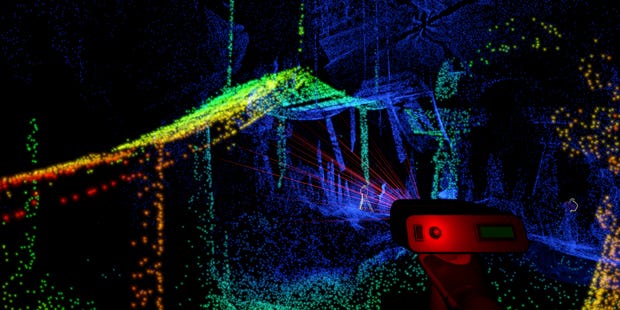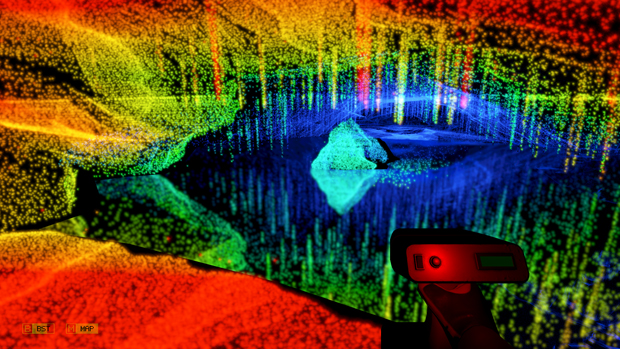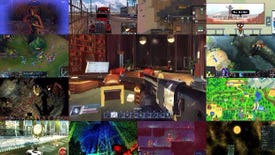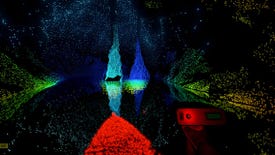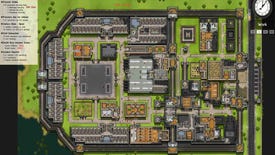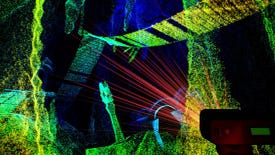State of the Art: Chris Delay talks Scanner Sombre
Rays of light
Scanner Sombre [official site] is Introversion's curious LIDAR-inspired exploration game. It caught my eye last year at Rezzed because it had such an unusual art style - the only thing close to it is A Light In Chorus and that does very different things with the specks of colour which make up its environments. In Scanner Sombre you use a scanning gun to reveal the world around you and to navigate its secrets.
A spectrum of colour helps you parse the terrain with bluer areas being far away and reds indicating what's nearest. Yellows and greens mark out the middle ground. It's an atmospheric game although it cleaves to a narrative I wasn't particularly interested in. That said, it managed to get under my skin to the point where I quit out forever about halfway through because I was TOO SCARED. But the art style is the thing which drew me in and which continues to absolutely fascinate me. Chris Delay, one of the studio's directors, was on hand to talk more so we delved into particle systems, maps and the secret mouse button function:
You can enlarge any of the images by clicking on them!
Pip: I played the prototype version of the game you brought to Rezzed in 2016 and the unusual art style was attracting a lot of attention. I'm interested to know how much of the look of the game was curated/intentional and how much was a result of using that particular scanner mechanism?
Chris Delay: The look of the game was very much intentional, and it was intended to have the look of industrial LIDAR scans. If you do a google image search for 'Lidar data', you'll find hundreds of examples of buildings, parks, rivers, bridges etc, all rendered in that recognisable style with strong rainbow colours usually representing elevation. I have always loved that look ever since I first saw it used in a Radiohead video. It's incredibly inhuman and depersonalised, like all the warmth of the world has been removed, and replaced with this point cloud. It's how I imagine machines will see the world! For a long while now I've wanted to make a game that was visualised in that way just because of the atmosphere that I think it creates.
Pip: The way the scanning works means you can look back and see the shapes of where you have been. You now have a map which you get given a little way into the game so can you tell me about the decision to add the map instead of relying on being able to look back?
Chris Delay: Partly we noticed during playtests that a lot of players just got completely lost! The map can help a great deal with that, because it helps the player to regain their orientation and figure out what direction they need to be heading in. But on top of that, I just love the look of it. Once you’ve been all around the world, there can be millions of points in your scan data, and it just looks incredible. Sometimes you can see that by looking backward, but much of the time it’s obscured by the nearby geometry.
Pip: What were the main challenges of designing a space where the player has to reveal their own path?
Chris Delay: We definitely had to lead the player quite strongly in some places. Due to the total absence of light, we were never able to use the traditional trick of putting a brighter/more lit room at the end of a long section to draw the player forwards. In fact we’ve never done a first-person exploration-type game like this before, so we did quite a bit of playtesting to make sure our players knew where they were supposed to be going. We also wanted the players to see specific things at specific times, and it can become quite difficult to get inside a player's head like that.
Pip: Do some environmental shapes work better than others? I imagine a corridor with no knobbly bits isn't as easy to "read" as one where the jagged bits offer colour contrasts and let you see depth better?
Chris Delay: Yes definitely, some types of geometry just don’t work at all when rendered as a point cloud. For a while we were trying to add surface details to statues, and you just couldn’t see it at all. It took us a while to discover what worked best, but generally speaking any feature that you want a player to notice has to be reasonably large, pushed forward from any walls (so it doesn’t just blend into them), and has to be a chunky enough shape that the player can tell what it is. It’s been a very unusual set of design constraints!
Pip: The water works really nicely, slowly dissolving your scan points and leaving a reflection. How did you come to that decision?
Chris Delay: From a purely technical standpoint it doesn’t really make sense that scan points on water dissolve away, or that water surfaces reflect the point clouds above them. But it’s all part of building the idea that something isn’t right within this cave. I also wanted the game to look really beautiful (in the way that only programmer art can!), so I wasn’t opposed to putting effects into the game that perhaps don’t entirely make sense, but work from an atmospheric or visual stand point.
Pip: As someone who got too scared in the lake section I cannot attest to the rest of the game, but the indistinctness of scanning and the way water causes glitchiness seems to work really well in setting up some tenser interactions. I'd be interested to hear more about the fine-tuning there - forcing players to get into the water and working out when to use audio versus when to use a visual representation of some events.
Chris Delay: We spent a huge amount of time setting up that lake. There are quite a few surprises in there and the way the player is guided through it initially helps to establish the danger and that feeling of tension that you mention. Scanner Sombre isn't a full on horror game but we do play with horror somewhat. Showing the player that water is dangerous for you and then forcing the player to go through it anyway seems to have a strong effect on players, and we’ve seen people jump out of their seats when they got trapped.
Pip: Are you planning to make the game easily moddable - either in terms of switching up the colour spectrum choices which could create cool effects or allowing people to experiment and design their own levels?
Chris Delay: It’s not a top priority for us to make the game moddable - it was designed to be a strong single-player experience, but we never imagined it having the kind of life that saw Prison Architect updated for years and years. That said, I’m sure shader mods would be pretty easy to accomplish. We’ve always been amazed at what modders can achieve with our games.
Pip: I've tried navigating sections without scanning, just so I can look back on sections and see them more clearly and became aware that I'm otherwise spending most of the game just holding the mouse button down to keep scanning. Were you ever considering the scanner being on by default and making someone hold the mouse button to stop it?
Chris Delay: I often play that way too, and I love seeing the point cloud taking shape behind you! There is an undocumented feature that you can click the middle mouse wheel to toggle the scanner on and off, if you get really tired of holding the mouse down.
Pip: The scanner itself leaves a grid pattern when you burst scan and stand still or if you just hold the trigger down. It feels like that was a decision which makes the scanner feel more like a crafted object with physical limitations. Is that fair or is it more to do with how the game technology/memory constraints/some other technical thing works?
Chris Delay: Yes it was intended to reinforce the idea that this LIDAR scanner is an industrial tool that leaves its own pattern on the world when used. Many genuine lidar scans have similar patterns visible in them - you can often very clearly see where the scanner was positioned (because of the shadows it leaves behind), and you can often see lines of scan points across the geometry due to the way the laser sweeps horizontally within the device.
Within Scanner Sombre, when you do a burst scan we simulate a laser sweeping across the geometry. It may be simulated, but the way our in-game scanner works is very similar to the way a real scanner works - we emit lasers just the same, we determine the range of the hit, we know the orientation of the emitter at that moment, and from that we determine where the point landed in 3D. The patterns you see occur naturally due to the way our in-game scanner operates.
Pip: From what I've played so far there's generally a bit of exploration regarding the segments of cave, but more to illuminate crevices than find secrets or alternative exits and so on. Is it harder to do the latter in a game with a non-traditional mode of display?
Chris Delay: Well there are a few secrets in the game :) Some players we imagine will scan to reveal and explore this underground world, others will be focussed on finding the way forward. We never really know how people are going to enjoy the game until it’s launched.
Pip: What's your favourite neat trick with the scanner or solution to a question which came up during development?
Chris Delay: From a technical standpoint, just getting the rendering system to comfortably handle the the sheer volume of particles was a major ongoing challenge. I knew I wanted the player to be free to scan as much as they wanted as they were running around, and also to look back and see the entire cave behind them as they explore. It just gives such an incredible sense of scale and place. Tools like the burst scanner put even more pressure on that particle count - it can easily be millions by the time you’ve been playing for a while. We put a ton of effort into writing our own dedicated particle system just for the point clouds, since it’s your primary view on the world.
Pip: Thank you for your time!
NOTE: In case you're interested or in case this is relevant to you as a player, I asked about whether there were any colour-blindness modes or if the current setup had been tested with players with forms of colourblindness. The issue is one which was raised by the studio's usability lab but the team haven't been able to come up with a solution pre-release. Mark Morris - also a director at Introversion - noted that in terms of Scanner Sombre he isn't even sure how possible it would be. That's not to say the studio is ruling it out but it's definitely a bit of a conundrum. Morris notes "we will explore it if it does become a major issue for people."
